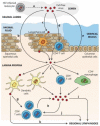Nanosystems Applied to HIV Infection: Prevention and Treatments
- PMID: 33212766
- PMCID: PMC7697905
- DOI: 10.3390/ijms21228647
Nanosystems Applied to HIV Infection: Prevention and Treatments
Abstract
Sexually-transmitted infections (STIs) are a global health concern worldwide as they cause acute diseases, infertility, and significant mortality. Among the bacterial, viral, and parasitic pathogens that can be sexually transmitted, human immunodeficiency virus (HIV) has caused one of the most important pandemic diseases, which is acquired immune deficiency syndrome (AIDS). 32.7 million people have died from AIDS-related illnesses since the start of the epidemic. Moreover, in 2019, 38 million people were living with HIV worldwide. The need to deal with this viral infection becomes more obvious, because it represents not only a problem for public health, but also a substantial economic problem. In this context, it is necessary to focus efforts on developing methods for prevention, detection and treatment of HIV infections that significantly reduce the number of newly infected people and provide a better quality of life for patients. For several decades, biomedical research has been developed allowing quick solutions through the contribution of effective tools. One of them is the use of polymers as vehicles, drug carrier agents, or as macromolecular prodrugs. Moreover, nanosystems (NSs) play an especially important role in the diagnosis, prevention, and therapy against HIV infection. The purpose of this work is to review recent research into diverse NSs as potential candidates for prevention and treatment of HIV infection. Firstly, this review highlights the advantages of using nanosized structures for these medical applications. Furthermore, we provide an overview of different types of NSs used for preventing or combating HIV infection. Then, we briefly evaluate the most recent developments associated with prevention and treatment alternatives. Additionally, the implications of using different NSs are also addressed.
Keywords: HIV infection; nanosystems; nanotechnology; prevention; treatment.
Conflict of interest statement
The authors declare no conflict of interest.
Figures




Similar articles
-
HIV infection and AIDS in the tropics.Med J Aust. 1993 Oct 18;159(8):549-51. doi: 10.5694/j.1326-5377.1993.tb138011.x. Med J Aust. 1993. PMID: 8412956
-
Problems of AIDS in India especially in women.Early Hum Dev. 1992 Jun-Jul;29(1-3):225-9. doi: 10.1016/0378-3782(92)90156-b. Early Hum Dev. 1992. PMID: 1396243
-
AIDS in sub-Saharan Africa: the epidemiology of heterosexual transmission and the prospects for prevention.Epidemiology. 1993 Jan;4(1):63-72. Epidemiology. 1993. PMID: 8420583 Review.
-
Women and AIDS in Zimbabwe: the making of an epidemic.Int J Health Serv. 1991;21(1):143-56. doi: 10.2190/N0NJ-FKXB-CT25-PA09. Int J Health Serv. 1991. PMID: 2004868
-
The human immunodeficiency virus epidemic in India. Current magnitude and future projections.Medicine (Baltimore). 1995 Mar;74(2):97-106. doi: 10.1097/00005792-199503000-00005. Medicine (Baltimore). 1995. PMID: 7891548 Review.
Cited by
-
Baseline and time-updated factors in preclinical development of anionic dendrimers as successful anti-HIV-1 vaginal microbicides.Wiley Interdiscip Rev Nanomed Nanobiotechnol. 2022 May;14(3):e1774. doi: 10.1002/wnan.1774. Epub 2022 Jan 12. Wiley Interdiscip Rev Nanomed Nanobiotechnol. 2022. PMID: 35018739 Free PMC article. Review.
-
Advances and Perspectives in the Use of Carbon Nanotubes in Vaccine Development.Int J Nanomedicine. 2021 Aug 12;16:5411-5435. doi: 10.2147/IJN.S314308. eCollection 2021. Int J Nanomedicine. 2021. PMID: 34408416 Free PMC article. Review.
-
Nano-Drug Delivery Systems Entrapping Natural Bioactive Compounds for Cancer: Recent Progress and Future Challenges.Front Oncol. 2022 Mar 29;12:867655. doi: 10.3389/fonc.2022.867655. eCollection 2022. Front Oncol. 2022. PMID: 35425710 Free PMC article. Review.
-
CMV Retinitis in the Context of SARS-CoV-2 Infection: A Case Study and Comprehensive Review of Viral Interactions.Pathogens. 2024 Oct 29;13(11):938. doi: 10.3390/pathogens13110938. Pathogens. 2024. PMID: 39599491 Free PMC article. Review.
-
Neuropathogenesis of acute HIV: mechanisms, biomarkers, and therapeutic approaches.Curr Opin HIV AIDS. 2025 May 1;20(3):199-208. doi: 10.1097/COH.0000000000000923. Epub 2025 Mar 26. Curr Opin HIV AIDS. 2025. PMID: 40110851 Free PMC article. Review.
References
-
- United Nations Programme on HIV/AIDS Global HIV & AIDS Statistics. [(accessed on 9 November 2020)];2020 Available online: www.unaids.org/en/resources/fact-sheet.
Publication types
MeSH terms
Grants and funding
LinkOut - more resources
Full Text Sources
Medical

